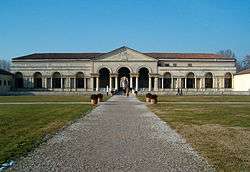Palazzo del Te
_-_BEIC_6346950.jpg)



Palazzo del Te or Palazzo Te is a palace in the suburbs of Mantua, Italy. It is a fine example of the mannerist style of architecture, the acknowledged masterpiece of Giulio Romano. The official name, and by far the most common name in Italian, is Palazzo Te, but this may be a relatively recent usage; Vasari calls it the "Palazzo Del T" (pronounced as "Te"), and English-speaking writers, especially art historians, continue to call it the Palazzo Del Te. In Italian this now suggests use for tea-drinking, which may account for the divergence in usage.
Description
Palazzo del Te is constructed 1524–34 for Federico II Gonzaga, Marquess of Mantua. He decided in 1524 to build a pleasure palace, or Villa Suburbana. The site chosen was that of the family's stables at Isola Del Te on the fringe of the marshes just outside Mantua's city walls.
The architect commissioned was Giulio Romano, a pupil of Raphael. The shell of the palazzo was erected within 18 months. It is basically a square house built around a cloistered courtyard. A formal garden complemented the house. This was enclosed by colonnaded outbuildings terminated by a semi-circular colonnade known as the 'Esedra'.
Like the Villa Farnesina in Rome, the suburban location allowed for a mixing of both Palace and Villa architecture. The four exterior façades have flat pilasters against rusticated walls, the fenestration indicating that the piano nobile is on the ground floor with a secondary floor above. The East façade differs from the other three by having Palladian motifs on its pilaster and an open loggia at its centre rather than an arch to the courtyard. The facades are not as symmetrical as they appear, and the spans between the columns are irregular. The centre of the North and South facades are pierced by two-storey arches without portico or pediment, simply a covered way leading to the interior courtyard.
Few windows overlook the inner courtyard ("cortile"); the colonnaded walls are decorated on all sides by deep niches and blind windows, and the intervening surfaces are spattered by 'spezzato' (broken and blemished plaster) giving life and depth to the surfaces.
Once the shell of the building was completed, for ten years a team of plasterers, carvers and fresco painters laboured, until barely a surface in any of the loggias or salons remained undecorated. Under Giulio Romano's direction, local decorative painters such as Benedetto Pagni and Rinaldo Mantovano worked extensively on the frescos. These frescoes remain today and are the most remarkable feature of the Palazzo. The subjects range from Olympian banquets in the Sala di Psiche and stylised horses in the Sala dei Cavalli to the most unusual of all — giants and grotesques wreaking havoc, fury and ruin around the walls of the Sala dei Giganti.

These magnificent rooms, once furnished to complement the ducal court of the Gonzaga family, saw many of the most illustrious figures of their era entertained such as the Emperor Charles V, who, when visiting in 1530, elevated his host Federico II of Gonzaga from Marquess to Duke of Mantua.
One of the most evocative parts of the lost era of the palazzo is the Casino della Grotta, a small suite of intimate rooms arranged around a grotto and loggetta (covered balcony) where courtiers once bathed in the small cascade that splashed over the pebbles and shells encrusted in the floor and walls.
In July 1630, during the War of the Mantuan Succession (1628–31), Mantua and the palace were sacked over three days by an Imperial army of 36,000 Landsknecht mercenaries. The remaining populace fell victim to one of the worst plagues in history that the invaders had brought with them. The Palazzo was looted from top to bottom and remained an empty shell: nymphs, god, goddesses and giants remain on the walls of the empty echoing rooms.
Part of the Palazzo today houses the Museo Civico del Palazzo Te, endowed by the publisher Arnoldo Mondadori. It contains a collection of Mesopotamian art.
Gallery
 Loggia
Loggia Internal façade
Internal façade Casino della Grotta
Casino della Grotta Fall of the Giants
Fall of the Giants
External links
| Wikimedia Commons has media related to Palazzo Te (Mantua). |
- Official website
- Mantua tourist guide Mantua tourist guide
References
- Summerson, John, The Classical Language of Architecture, 1980 edition, Thames and Hudson World of Art series, ISBN 0500201773
Coordinates: 45°08′53″N 10°47′10″E / 45.148°N 10.786°E